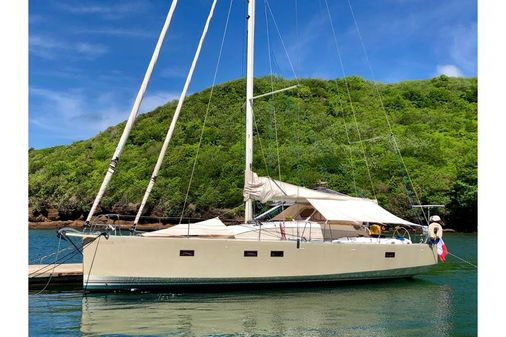- Home
- Cruising Yachts 35' to 40'
- RM 1260 Sailboat
The RM 1260 Sailboat
Specs & Key Performance Indicators
The RM 1260 sailboat, designed by French naval architect Marc Lombard, showcases advanced engineering and design techniques. It is built by Fora Marine, a prominent French shipbuilder located in La Rochelle, France.

Published Specification for the RM 1260 Sailboat
Keel & Rudder Configuration: Two keel/rudder options*
Hull Material: Plywood (with epoxy resin and fiberglass sheathing)
Length Overall: 41'4" (12.60m)
Waterline Length: 39'4" (12.00m)
Beam: 14'2" (4.32m)
Draft: 6'7" (2.00m)
Rig Type: Fractional cutter
Displacement: 16,535lb (7,500kg)
Ballast: 5,732lb (2,600kg)
Designer: Marc Lombard
Builder: Fora Marine
Year First Built: 2012
Year Last Built: Still in production as of the latest update
Number Built to Date: Not specified
* Keel/rudder options:
- Twin keels and single rudder: This configuration minimizes draft, allowing the boat to dryout safely.
- Single keel and twin rudders: Provides maximum performance, particularly if fitted with a carbon mast.
Published Design Ratios for the RM 1260 Sailboat
The Key Performance Indicators (KPIs)
- Sail Area/Displacement Ratio (24.4): This ratio suggests that the RM 1260 is a high-performance sailboat. With a Sail Area/Displacement ratio above 20, it indicates that the boat has ample sail area relative to its weight. This translates to potentially faster sailing speeds, agile handling, and a more responsive performance, particularly in lighter winds.
- Ballast/Displacement Ratio (36.0): A ratio of 36% indicates a reasonable amount of ballast relative to the boat's total displacement, which contributes to its stability and ability to "stand up" to the wind without excessive heeling. However, this value does not specify the distribution of the ballast. For better performance and stability, it would be ideal if the ballast was concentrated lower down, such as in a bulb at the keel's foot.
- Displacement/Length Ratio (136): This falls into the light displacement category (100-200). Light displacement boats can generally achieve higher speeds with less sail area and are often more nimble and quicker to accelerate. They are usually easier to handle in various wind conditions but can be more affected by waves compared to heavier boats.
- Comfort Ratio (12.7): A comfort ratio below 20 indicates that the RM 1260 is associated with the motion of a lightweight racing boat. This suggests that while the boat may be fast and responsive, it is likely to have a more pronounced motion in the water, which can be less comfortable for the crew, especially in rough seas.
- Capsize Screening Formula (2.2): With a value of 2.2, the RM 1260 is on the cusp but slightly above the threshold for bluewater cruising capability, which is generally considered to be 2.0 or less. This implies that while the boat is relatively beamy, it might be more susceptible to capsizing in extreme conditions than boats specifically designed for open ocean passages. It is more suitable for coastal cruising and may occasionally venture into bluewater, but with some caution.
When interpreting these ratios, it is crucial to remember their theoretical nature and certain limitations. For example:
- Ballast/Displacement Ratio: This ratio does not account for the vertical distribution of the ballast. A higher ballast ratio is generally good, but it is also essential to consider how the ballast is placed. A deep keel with a bulb can provide more righting moment and stability compared to a shallow keel with evenly distributed ballast.
- Comfort Ratio: Ted Brewer's Comfort Ratio inherently favours heavier, more narrow-beamed boats with long overhangs, which do not align with the designs of many modern light-displacement, beamy cruisers with plumb bows. These modern designs might provide a different kind of comfort and safety, particularly in terms of speed and hydrodynamic efficiency, which aren't captured by the comfort ratio.
Overall, while these ratios provide a useful starting point for assessing the RM 1260 sailboat, they must be supplemented with practical experience, modern design insights, and considerations of specific sailing conditions and the intended use of the vessel.
Here's how to calculate the KPIs yourself - without having to wrestle with the mathematics...
Yachting Press Reviews for the RM 1260 Sailboat
Robert H Perry, writing for Sailing Magazine tells us...
"Here is an unusual design from French designer Marc Lombard. What makes this design so unusual is that it is a production model with a hull built of marine plywood and epoxy. Production boats built of plywood are not new. There was the old Newporter series built in California in the early 1960s. But this is a very modern design and it should appeal to sailors looking for comfort and good performance." Read more...
This article was written with the assistance of Gemini, a large language model developed by Google. Gemini was used to gather information, summarize research findings, and provide suggestions for the content and structure of the article.
Recent Articles
-
Ohlson 38 Guide: Specs, Performance Analysis & Cruising Review
Jan 07, 26 05:52 AM
Discover the Ohlson 38 sailboat. An in-depth look at its Einar Ohlson design, Tyler GRP construction, performance ratios, and why it remains a top choice for offshore sailors. -
Passoa 47 Sailboat Review: Comprehensive Specs & Performance Analysis
Jan 04, 26 04:57 AM
Discover the Passoa 47, a legendary aluminium blue water cruiser by Garcia. Explore technical specifications, design ratios, and why its lifting keel is a game-changer for offshore sailors. -
Sailboat Wheel Steering Maintenance & Inspection Checklist
Dec 30, 25 02:32 PM
Keep your vessel’s helm responsive and reliable with our expert maintenance checklist. Master cable tensioning and system inspections to avoid mid-passage failures.












